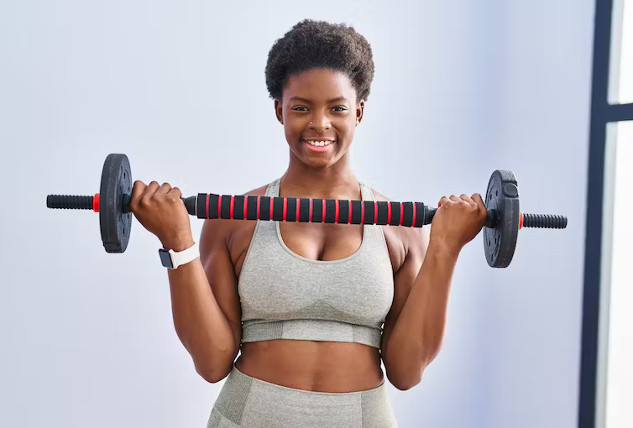
Resistance training works about as well as aerobic exercise in all the critical areas, including cardiovascular health. (Shutterstock)
Everyone can agree that exercise is healthy. Among its many benefits, exercise improves heart and brain function, aids in controlling weight, slows the effects of aging and helps lower the risks of several chronic diseases.
For too long, though, one way of keeping fit, aerobic exercise, has been perceived as superior to the other, resistance training, for promoting health when, in fact, they are equally valuable, and both can get us to the same goal of overall physical fitness.
Aerobic exercise such as running, swimming and cycling is popular because it provides great benefits and with ample scientific evidence to back that up.
What has been far less influential to date is that resistance training — whether that’s with dumbbells, weightlifting machines or good old push-ups, lunges and dips — works about as well as aerobic exercise in all the critical areas, including cardiovascular health.
Resistance training provides another benefit: building strength and developing power, which become increasingly important as a person ages. Video about different forms of resistance training explores how all are effective at building strength.
Building and maintaining muscle strength keeps us springing out of our chairs, maintaining our balance and posture and firing our metabolism, as my colleagues and I explain in a paper recently published by the American College of Sports Medicine.
So, if aerobic exercise and resistance training offer roughly equal benefits, how did we end up with so many runners and cyclists compared to weightlifters?
It was a combination of timing, marketing and stereotyping.
The rise of aerobics
The preference for aerobic exercise dates back to landmark research from the Cooper Centre Longitudinal Study, which played a pivotal role in establishing the effectiveness of aerobics — Dr. Ken Cooper invented or at least popularized the word with his book Aerobics, spurring desk-bound Baby Boomers to take up exercise for its own sake.
Meanwhile, resistance training languished, especially among women, due to the misguided notion that weightlifting was only for men who aspired to be hyper-muscular. Charles Atlas, anyone?
Cultural influences solidified the dominance of aerobic exercise in the fitness landscape. In 1977, Jim Fixx made running and jogging popular with The Complete Book of Running. In the 1980s, Jane Fonda’s Complete Workout and exercise shows such as Aerobicize and the 20 Minute Workout helped solidify the idea that exercise was about raising one’s heart rate.
The very word “aerobic,” previously confined to the lexicon of science and medicine, entered popular culture about the same time as leg warmers, tracksuits and sweatbands. It made sense to many that breathing hard and sweating from prolonged, vigorous movement was the best way to benefit from exercising.
All the while, resistance training was waiting for its turn in the spotlight.
Recognizing the value of resistance
If aerobics has been the hare, resistance training has been the tortoise. Weight training is now coming up alongside and preparing to overtake its speedy rival, as athletes and everyday people alike recognize the value that was always there.
Even in high-level sports training, weightlifting did not become common until the last 20 years. Today, it strengthens the bodies and lengthens the careers of soccer stars, tennis players, golfers and many more.
Rising popular interest in resistance training owes a debt to CrossFit, which, despite its controversies, has helped break down stereotypes and introduced more people, particularly women, to the practice of lifting weights.
It’s important to recognize that resistance training does not invariably lead to bulking up, nor does it demand lifting heavy weights. As our team’s research has shown, lifting lighter weights to the point of failure in multiple sets provides equal benefits.
Strength and aging
The merits of resistance training extend beyond improving muscle strength. It addresses a critical aspect often overlooked in traditional aerobic training: the ability to exert force quickly, or what’s called power. As people age, activities of daily living such as standing up, sitting down and climbing stairs demand strength and power more than cardiovascular endurance.
In this way, resistance training can be vital to maintaining overall functionality and independence.
Redefining the fitness narrative
The main idea is not to pit resistance training against aerobic exercise but to recognize that they complement each other. Engaging in both forms of exercise is better than relying on one alone. The American Heart Association recently stated that “…resistance training is a safe and effective approach for improving cardiovascular health in adults with and without cardiovascular disease.”
Adopting a nuanced perspective is essential, especially when we guide older individuals who may associate exercise primarily with walking and not realize the limitations imposed by neglecting strength and power training.
Resistance training is not a one-size-fits-all endeavour. It encompasses a spectrum of activities tailored to individual capabilities.
It’s time to redefine the narrative around fitness to make more room for resistance training. It’s not necessary to treat it as a replacement for aerobic exercise but to see it as a vital component of a holistic approach to health and longevity.
By shedding stereotypes, demystifying the process and promoting inclusivity, resistance training can become more accessible and appealing to a broader audience, ultimately leading to a new way to perceive and prioritize the benefits of this form of training for health and fitness.![]()
Stuart Phillips, Professor, Kinesiology, Tier 1 Canada Research Chair in Skeletal Muscle Health, McMaster University
This article is republished from The Conversation under a Creative Commons license. Read the original article.
Books on Exercise from Amazon's Best Sellers list
The Four-Pack Revolution: How You Can Aim Lower, Cheat on Your Diet, and Still Lose Weight and Keep It Off
by Chael Sonnen and Ryan Parsons
The Four-Pack Revolution presents a total-life approach for attaining health and fitness goals without the hard work and suffering.
Click for more info or to order
Bigger Leaner Stronger: The Simple Science of Building the Ultimate Male Body
by Michael Matthews
If you want to build muscle, lose fat, and look great as quickly as possible without steroids, good genetics, or wasting ridiculous amounts of time in the gym and money on supplements, then you want to read this book.
Click for more info or to order
The Women's Health Big Book of Exercises: Four Weeks to a Leaner, Sexier, Healthier You!
by Adam Campbell
The Women's Health Big Book of Exercises is the essential workout guide for anyone who wants a better body. As the most comprehensive collection of exercises ever created, this book is a body-shaping power tool for both beginners and longtime fitness buffs alike.
Click for more info or to order
Bodyweight Strength Training Anatomy
by Bret Contreras
In Bodyweight Strength Training Anatomy, author and renowned trainer Bret Contreras has created the authoritative resource for increasing total-body strength without the need for free weights, fitness machines, or even a gym.
Click for more info or to order
The Men's Health Big Book of Exercises: Four Weeks to a Leaner, Stronger, More Muscular You!
by Adam Campbell
The Men's Health Big Book of Exercises is the essential workout guide for anyone who wants a better body. As the most comprehensive collection of exercises ever created, this book is a body-shaping power tool for both beginners and longtime fitness buffs alike.






















